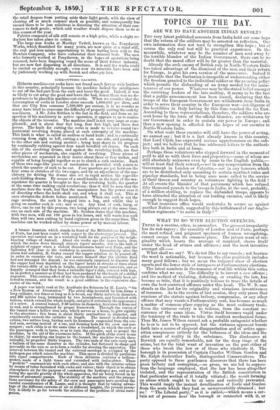CONS-CDITEKG MACHLN - E.
Hitherto machine-cut corks have not found much favour with bottlers in this country, principally because the machine lacked the intelligence to cut off the bad part from the cork and leave the good. Indeed, it was as likely to cut away the good and leave the bad, hence there was no de- pendence to be placed in machine-cut corks. When we consider that the consumption of corks in London alone exceeds 1,000,000 per diem, and that one City firm consume 7,200,000 per annum, it is no wonder so many have tried to overcome the difficulty of properly cutting the cork by machinery. A Mr. John Seithen is the last in the field, and from an in- spection of his machinery in active operation, it appears to us to realize the objects of the inventor. The machine itself is not very large or com- plicated; and is about four feet long, four feet high, and three feet across. The knife for cutting the corks is made to revolve round two horizontal revolving drums, placed at each extremity of the machine. This knife is what is called an endless or band knife ; and is continually running from right to left, cutting a cork on one side, and passing on to the other side and cutting another ; being kept sharp in its progress by continually rubbing against four small bevelled oil stones. On each side of the revolving drums, and against the revolving knife, are four other pieces of mechanism, also capable of revolving. These pieces of mechanism are separated in their centre about three or four inches, and capable of being brought together so as to clutch a cork endwise. Each of these two cage-like pieces of mechanism is provided with points to clutch the quarter of cork to be cut. Four quarters are put between the four arms or clutches of the two cages, and by an adjustment of the ma- chinery for driving the drums also set in rapid motion the cage-like cork-holding drums. By means of a small handle in the hand of the ma- nipulator the quarter is brought to face the revolving knife, the quarter at the same time making rapid revolutions ; thus it will be seen that the machine does the work. but that the manipulator has the power over it of directing where the knife shall cut, and when it shall cut. This at once obviates the defects before mentioned. When one cork is cut the cage revolves, the cork is dropped into a bag, and whilst this is going on another cork is cut ; and so on. Any kind of cork, bung, or chive, can be cut by this process, two being always cut at the same time, one on each side of the machine. Mr. Seithen states that this machine, with two men, will cut 100 gross in ten hours, and will waste less cork than will two men cutting by hand eighteen gross in the same time. The machine can be worked either by steam power or by manual labour.


























 Previous page
Previous page